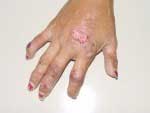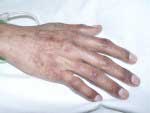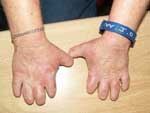Which Forms of Porphyria Develop Skin Disease?
Skin disease is limited to:
- variegate porphyria (VP)
- porphyria cutanea tarda (PCT)
- hereditary coproporphyria (HCP)
- congenital erythropoietic porphyria (CEP)
- erythropoietic protoporphyria (EPP)

Description of Skin in Porphyria
Note that patients with erythropoietic protoporphyria (EPP) have a very specific pattern of skin disease, which is described on a separate page: Erythropoietic Protoporphyria.
In the case of the other porphyrias, the following are the principal changes noted in the skin:
Areas affected
Sun-exposed areas, particularly the backs of the hands, followed by the face and forearms; sometimes the back of the neck, feet and lower legs in those who wear shorts, short dresses or open sandals.
Increased fragility

Blisters
These are areas where the skin has split, with the space between the layers being filled with fluid. The blisters may vary in size from very small to several centimeters.
Erosions
These consist of open sores. They are typically small and not particularly noticeable. There may be one or several at a time. In more severely affected people, the erosions may be several centimeters in size. If they become infected, they become mucky and may show pus.
Changes in response to healing

Small blisters and erosions, cared for properly, may heal and disappear completely. In many cases however, they leave behind small marks: areas lighter or darker than normal skin (referred to as hypopigmentation and hyperpigmentation respectively). One might also note milia: small waxy pinpoint deposits just under the skin. These changes are typically most obvious on the backs of the hands, the areas most prone to sun exposure and to injury. In severe cases, the damage may be followed by thinning and shrinking of the skin, leading to a tightness of the skin of the hands and face. This is sometimes seen in porphyria cutanea tarda, where it is occasionally mistaken for an unrelated disease called scleroderma. The damage skin may also become abnormally hairy, a condition known as hypertrichosis. Damage to the scalp may also lead to areas of hair loss (alopecia), and fingernails may be lost or damaged.

Photomutilation
Under very rare circumstances, skin damage is severe to the point that the eyes, lips or nose become contracted and may even disappear. This is known as photomutilation.This is not a feature of typical variegate porphyria, porphyria cutanea tarda or hereditary coproporphyria. It is particularly a feature of homozygous porphyrias: a rare circumstance in which an individual inherits a gene containing a mutation from both mother and father. This is seen in the homozygous forms of the two autosomal dominant conditions porphyria cutanea tarda and variegate porphyria, and in the autosomal recessive condition congenital erythropoietic porphyria.

How Does the Skin Disease of Porphyria Come About?
In patients with porphyria, high levels of porphyrins may circulate in the blood and are deposited in the skin. Porphyrins are photoactive molecules, the property responsible for their fluorescence. When a light ray (particularly one with a wavelength in the ultraviolet range) strikes a porphyrin molecule, the energy of the light is absorbed by the molecule, and some of its electrons become more active (technically we say that they are promoted to a higher energy level). In due course, the molecule "relaxes" by allowing the promoted electrons to drop back to a normal energy level. To do so, they must give out the extra energy they contain. This is radiated out as heat and light. If this takes place in the skin, it causes damage. It is for this reason that the skin disease of porphyria is usually restricted to areas which are exposed to the sun, and that avoiding sun exposure is so important in preventing skin disease.
Treatment of Skin Disease
Read the page Treatment of skin disease in porphyria.